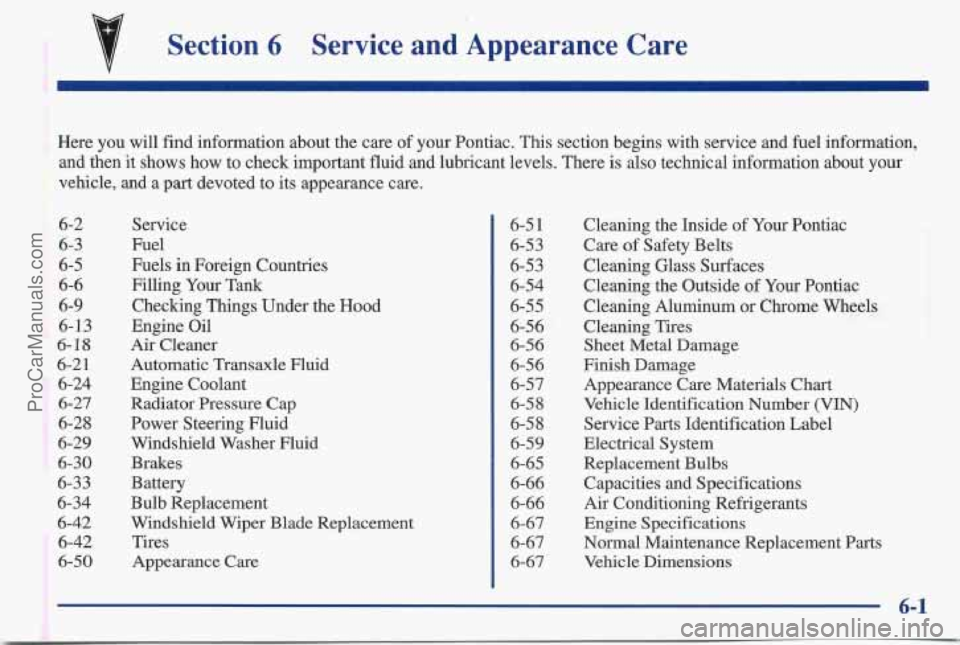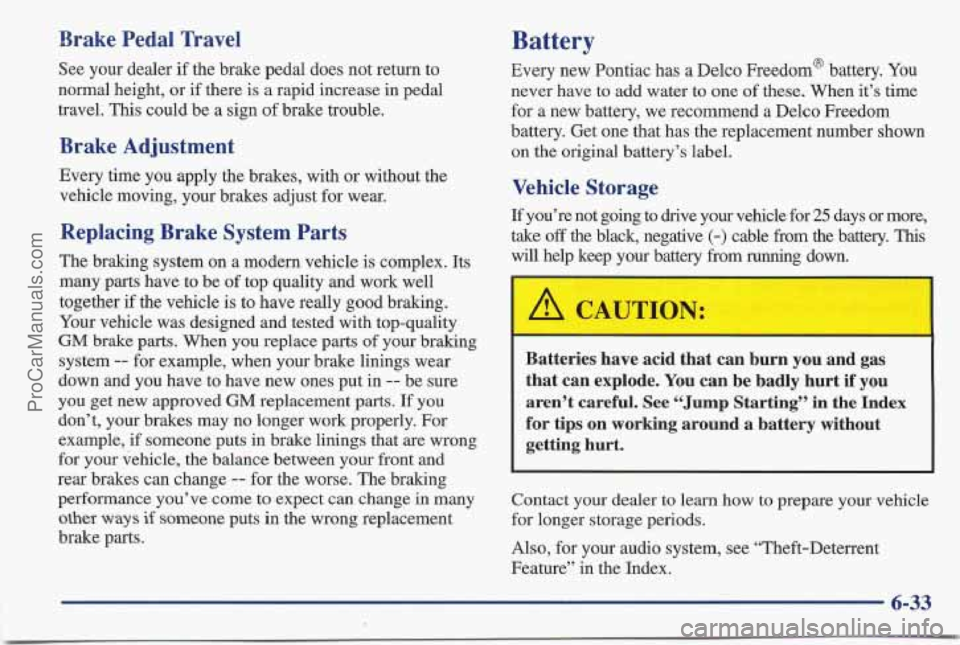Page 219 of 405
7. Connect the red positive (+) cable to the positive (+)
terminal of the vehicle with the dead battery. Use a
remote positive
(+) terminal if the vehicle has one.
8. Don’t let the other end
touch metal. Connect
it to the positive
(+)
terminal of the good
battery. Use a remote
positive
(+) terminal if
the vehicle has one.
Now connect the black
negative
(-) cable to
the good battery’s
negative
(-) terminal.
Don’t let the
other end
touch anything until the
next step. The
other end
of the negative cable
duesn’t go to the
dead battery.
It goes to a heavy unpainted metal part on the engine of
the vehicle with the dead battery.
ProCarManuals.com
Page 254 of 405

v Section 6 Service and Appearance Care
Here you will find information about the care of your Pontiac. This section begins with service and fuel information,
and then it shows how to check important fluid and lubricant levels. There is also technical information about your
vehicle, and a
part devoted to its appearance care.
6-2
6-3
6-5
6-6
6-9
6-13
6-18
6-2 1
6-24
6-27
6-28
6-29
6-30
6-33
6-34
6-42
6-42
6-50 Service
Fuel
Fuels in Foreign Countries
Filling Your Tank
Checking Things Under the Hood
Engine Oil
Air Cleaner
Automatic Transaxle Fluid
Engine Coolant
Radiator Pressure Cap
Power Steering Fluid
Windshield Washer Fluid
Brakes
Battery
Bulb Replacement
Windshield Wiper Blade Replacement
Tires
Appearance
Care
6-5 1
6-53
6-53
6-54
6-55
6-56
6-56
6-56
6-57 6-58
6-58
6-59
6-65
6-66
6-66
6-67
6-67
6-67 Cleaning the Inside
of
Your Pontiac
Care
of Safety Belts
Cleaning Glass Surfaces Cleaning the Outside of Your Pontiac
Cleaning Aluminum
or Chrome Wheels
Cleaning Tires Sheet Metal Damage
Finish Damage
Appearance Care Materials Chart
Vehicle Identification Number (VIN)
Service Parts Identification Label
Electrical System
Replacement Bulbs
Capacities and Specifications
Air Conditioning Refrigerants
Engine Specifications
Normal Maintenance Replacement Parts
Vehicle Dimensions
ProCarManuals.com
Page 264 of 405
3800 Series I1 Engine (L36 - Code K)
When you open the hood, you’ll see:
A. Engine Coolant Recovery Tank
B. Battery
C. Radiator Pressure Cap
D. Engine Oil Dipstick G. Brake Master Cylinder
E. Engine Oil Fill Cap H. Air Cleaner
E Automatic Transaxle Fluid Dipstick I. Windshield Washer Fluid Reservoir
6-11
ProCarManuals.com
Page 265 of 405
3800 Supercharged Engine (L67 - Code 1) (Option)
When you open the hood, you'll see:
A. Engine Coolant Recovery Tank D. Engine Oil Dipstick G. Brake Master Cylinder
B. Battery
E. Engine Oil Fill Cap H. Air Cleaner
C. Radiator Pressure Cap E Automatic Transaxle Fluid Dipstick I. Windshield Washer Fluid Reservoir
6-12
ProCarManuals.com
Page 286 of 405

Brake Pedal Travel
See your dealer if the brake pedal does not return to
normal height, or if there
is a rapid increase in pedal
travel. This could be a sign of brake trouble.
Brake Adjustment
Every time you apply the brakes, with or without the
vehicle moving, your brakes adjust for wear.
Replacing Brake System Parts
The braking system on a mo’dern vehicle is complex. Its
many parts have to be of top quality and work well
together
if the vehicle is to have really good braking.
Your vehicle was designed and tested with top-quality
GM brake parts. When you replace parts of your braking
system
-- for example, when your brake linings wear
down and you have to have new ones put in
-- be sure
you get new approved
GM replacement parts. If you
don’t, your brakes may no longer work properly. For
example, if someone puts in brake linings that are wrong
for your vehicle, the balance between your front and
rear brakes can change
-- for the worse. The braking
performance you’ve come
to expect can change in many
other ways if someone puts in the wrong replacement
brake parts.
Battery
Every new Pontiac has a Delco Freedom@ battery. You
never have to add water to one
of these. When it’s time
for a new battery, we recommend
a Delco Freedom
battery. Get one that has the replacement number shown
on the original battery’s label.
Vehicle Storage
If you’re not going to drive your vehicle for 25 days or more,
take
off the black, negative (-) cable from the battery. This
will help keep your battery from running down.
Batteries have acid that can burn you and gas
that can explode. You can be badly hurt if
you
aren’t careful. See “Jump Starting” in the Index
for tips on working around a battery without
getting hurt.
Contact your dealer to learn how to prepare your vehicle
for longer storage periods.
Also, for your audio system, see “Theft-Deterrent
Feature”
in the Index.
6-33
ProCarManuals.com
Page 316 of 405
Fuse
5B
6B
7B
8B
9B
1c
2c
3c
4c
5c
6C
7c
8C
9c
1D
2D
3D
4D
5D
Usage
Anti-Lock Brake System, Computer Command Ride
Brake and Hazard Lamps
Not Used Interior Lighting
Cigarette Lighter
Air Bag System Spare
Not Used
Not Used
Cooling Fans, Transaxle
Parking LampsDnterior Lamps
Not Used
Not Used
(Battery), Radio, Cluster
Ignition (Run/Crank), Chime, Cluster Spare
Heated Mirror
Not Used
Base A/C
Fuse Usage
6D Fog Lamps
7D Not Used
8D Radio
9D Not Used
1E Not Used
2E Air Bag System, PASS-Key
3E Not Used
4E Not Used
5E Rear Defog
6E Non-OBD I1 Engine Miscellaneous
7E Not Used
8E Wipers, Washer
9E Not Used
Passenger’s Side Fuse Block
Additional fuses are located in the relay center, on the
passenger’s side, below the instrument panel. You must
remove the sound insulator on the right side
of the
passenger footwell to replace these
fuses.
Since replacing these fuses is difficult. We recommend
that you see your dealer if you need one replaced.
6-63
ProCarManuals.com
Page 404 of 405
10. Attach the cable at least 18 inches (45 cm) away
from the dead battery, but not near engine parts that
move. The electrical connection is just as good
there, but the chance
of sparks getting back to the
battery is much less.
the engine for a while.
11. Now start the vehicle with the good battery and run
12. Try to start the vehicle with the dead battery.
If
it won't start after a few tries, it probably
needs service.
13. Remove the cables in reverse order to prevent
electrical shorting. Take care that they don't touch
each other or any other metal.
A. Heavy Metal Engine Part
B. Good Battery
C. Dead Battery
5-7
ProCarManuals.com
Page:
< prev 1-8 9-16 17-24